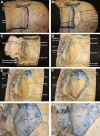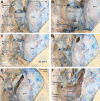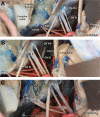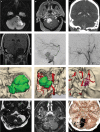Anatomical Step-by-Step Dissection of Complex Skull Base Approaches for Trainees: Surgical Anatomy of the Far Lateral Approach
- PMID: 36895809
- PMCID: PMC9991529
- DOI: 10.1055/a-1760-2528
Anatomical Step-by-Step Dissection of Complex Skull Base Approaches for Trainees: Surgical Anatomy of the Far Lateral Approach
Abstract
Introduction Skull base neuroanatomy is classically taught using surgical atlases. Although these texts are critical and rich resources for learning three-dimensional (3D) relationships between key structures, we believe they could be optimized and complemented with step-by-step anatomical dissections to fully meet the learning needs of trainees. Methods Six sides of three formalin-fixed latex-injected specimens were dissected under microscopic magnification. A far lateral craniotomy was performed by each of three neurosurgery resident/fellow at varying stages of training. The study objective was the completion and photodocumentation of the craniotomy to accompany a stepwise description of the exposure to provide a comprehensive, intelligible, and anatomically oriented resource for trainees at any level. Illustrative case examples were prepared to supplement approach dissections. Results The far lateral approach provides a wide and versatile corridor for posterior fossa operation, with access spanning the entire cerebellopontine angle (CPA), foramen magnum, and upper cervical region. Key Steps Include The study includes the following steps: positioning and skin incision, myocutaneous flap, placement of burr holes and sigmoid trough, fashioning of the craniotomy bone flap, bilateral C1 laminectomy, occipital condyle/jugular tubercle drilling, and dural opening. Conclusion Although more cumbersome than the retrosigmoid approach, a far lateral craniotomy offers unparalleled access to lesions centered lower or more medially in the CPA, as well as those with significant extension into the clival or foramen magnum regions. Dissection-based neuroanatomic guides to operative approaches provide a unique and rich resource for trainees to comprehend, prepare for, practice, and perform complex cranial operations, such as the far lateral craniotomy.
Keywords: complex cranial surgery; education; far lateral; foramen magnum; lateral skull base; meningioma; simulation.
Thieme. All rights reserved.
Conflict of interest statement
Conflict of Interest None declared.
Figures







Similar articles
-
Anatomical Step-by-Step Dissection of Complex Skull Base Approaches for Trainees: Surgical Anatomy of the Retrosigmoid Approach.J Neurol Surg B Skull Base. 2021 Jun;82(3):321-332. doi: 10.1055/s-0039-1700513. Epub 2019 Oct 28. J Neurol Surg B Skull Base. 2021. PMID: 34026408 Free PMC article.
-
Anatomical Step-by-Step Dissection of Complex Skull Base Approaches for Trainees: Surgical Anatomy of the Translabyrinthine and Transcochlear Approaches.J Neurol Surg B Skull Base. 2024 May 13;86(3):342-352. doi: 10.1055/s-0044-1786736. eCollection 2025 Jun. J Neurol Surg B Skull Base. 2024. PMID: 40351883 Free PMC article.
-
Anatomical Step-by-Step Dissection of Complex Skull Base Approaches for Trainees: Surgical Anatomy of the Frontotemporal and Orbitozygomatic Craniotomies.J Neurol Surg B Skull Base. 2023 Apr 27;85(4):370-380. doi: 10.1055/a-2065-9495. eCollection 2024 Aug. J Neurol Surg B Skull Base. 2023. PMID: 38966301 Free PMC article.
-
Foramen magnum meningiomas.Handb Clin Neurol. 2020;170:167-174. doi: 10.1016/B978-0-12-822198-3.00038-0. Handb Clin Neurol. 2020. PMID: 32586488 Review.
-
Evolution and advances of the lateral surgical approaches to cranial base neoplasms.J Neurooncol. 1994;20(3):337-61. doi: 10.1007/BF01053048. J Neurooncol. 1994. PMID: 7844626 Review.
Cited by
-
Vestibular schwannoma coexisting with dermoid cyst: A case report.Oncol Lett. 2024 Jan 25;27(3):121. doi: 10.3892/ol.2024.14256. eCollection 2024 Mar. Oncol Lett. 2024. PMID: 38348385 Free PMC article.
References
-
- Rhoton A L., JrThe far-lateral approach and its transcondylar, supracondylar, and paracondylar extensions Neurosurgery 200047(3, suppl)S195–S209. - PubMed
-
- Lanzino G, Paolini S, Spetzler R F.Far-lateral approach to the craniocervical junction Neurosurgery 200557(4, suppl) discussion 367–371367–371. - PubMed

